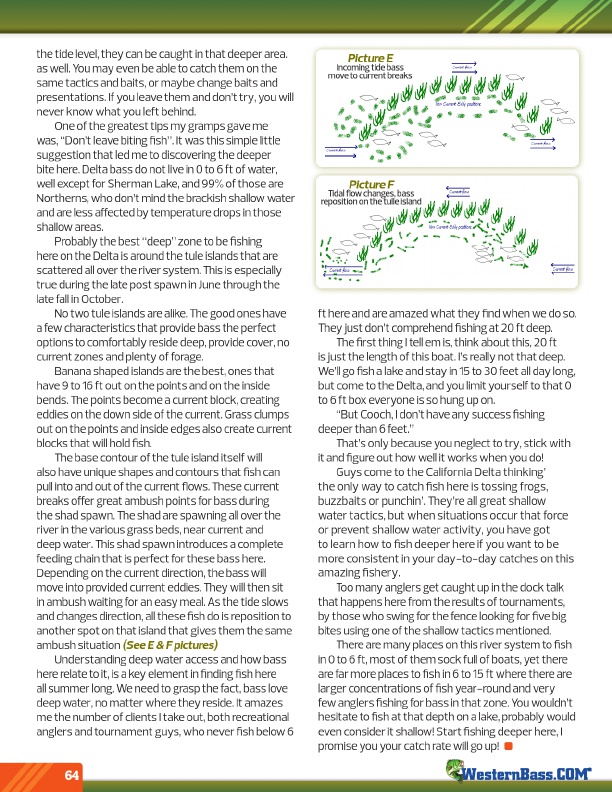
®
the tide level, they can be caught in that deeper area. as well. You may even be able to catch them on the same tactics and baits, or maybe change baits and presentations. If you leave them and don’t try, you will never know what you left behind.
One of the greatest tips my gramps gave me was, “Don’t leave biting fish”. It was this simple little suggestion that led me to discovering the deeper bite here. Delta bass do not live in 0 to 6 ft of water, well except for Sherman Lake, and 99% of those are Northerns, who don’t mind the brackish shallow water and are less affected by temperature drops in those shallow areas.
Probably the best “deep” zone to be fishing here on the Delta is around the tule islands that are scattered all over the river system. This is especially true during the late post spawn in June through the late fall in October.
No two tule islands are alike. The good ones have a few characteristics that provide bass the perfect options to comfortably reside deep, provide cover, no current zones and plenty of forage.
Banana shaped islands are the best, ones that have 9 to 16 ft out on the points and on the inside bends. The points become a current block, creating eddies on the down side of the current. Grass clumps out on the points and inside edges also create current blocks that will hold fish.
The base contour of the tule island itself will also have unique shapes and contours that fish can pull into and out of the current flows. These current breaks offer great ambush points for bass during the shad spawn. The shad are spawning all over the river in the various grass beds, near current and deep water. This shad spawn introduces a complete feeding chain that is perfect for these bass here. Depending on the current direction, the bass will move into provided current eddies. They will then sit in ambush waiting for an easy meal. As the tide slows and changes direction, all these fish do is reposition to another spot on that island that gives them the same ambush situation (See E & F pictures)
Understanding deep water access and how bass here relate to it, is a key element in finding fish here all summer long. We need to grasp the fact, bass love deep water, no matter where they reside. It amazes me the number of clients I take out, both recreational anglers and tournament guys, who never fish below 6
64
Inco P m ic in t g u t r id e e E bass
move to current breaks
Tidal fl P ow ic c t h u a r n e ge F s, bass
reposition on the tulle island
ft here and are amazed what they find when we do so. They just don’t comprehend fishing at 20 ft deep.
The first thing I tell em is, think about this, 20 ft is just the length of this boat. I’s really not that deep. We’ll go fish a lake and stay in 15 to 30 feet all day long, but come to the Delta, and you limit yourself to that 0 to 6 ft box everyone is so hung up on.
“But Cooch, I don’t have any success fishing deeper than 6 feet.”
That’s only because you neglect to try, stick with it and figure out how well it works when you do!
Guys come to the California Delta thinking’ the only way to catch fish here is tossing frogs, buzzbaits or punchin’. They’re all great shallow water tactics, but when situations occur that force or prevent shallow water activity, you have got to learn how to fish deeper here if you want to be more consistent in your day-to-day catches on this amazing fishery.
Too many anglers get caught up in the dock talk that happens here from the results of tournaments, by those who swing for the fence looking for five big bites using one of the shallow tactics mentioned.
There are many places on this river system to fish in 0 to 6 ft, most of them sock full of boats, yet there are far more places to fish in 6 to 15 ft where there are larger concentrations of fish year-round and very few anglers fishing for bass in that zone. You wouldn’t hesitate to fish at that depth on a lake, probably would even consider it shallow! Start fishing deeper here, I promise you your catch rate will go up!